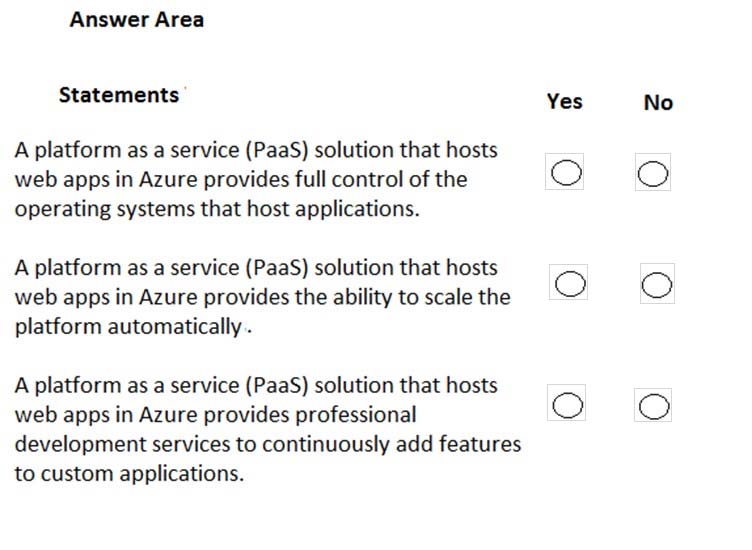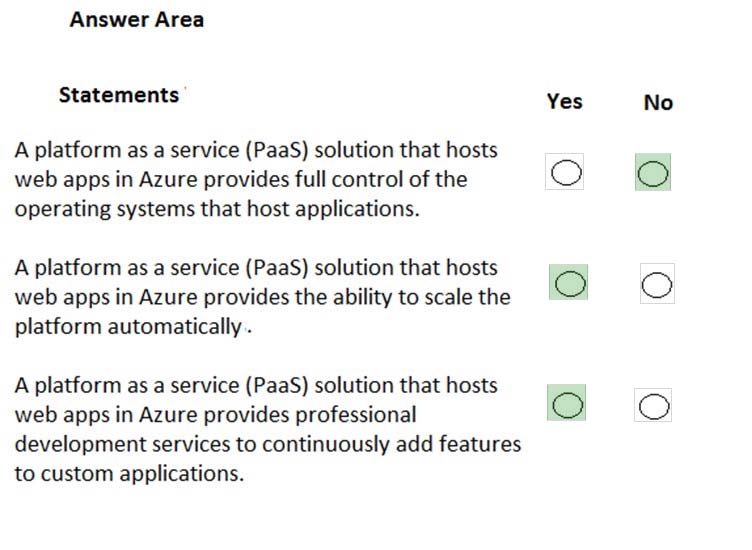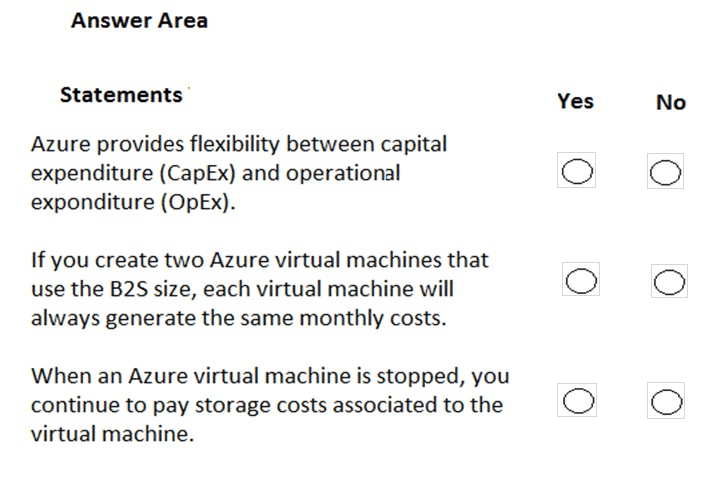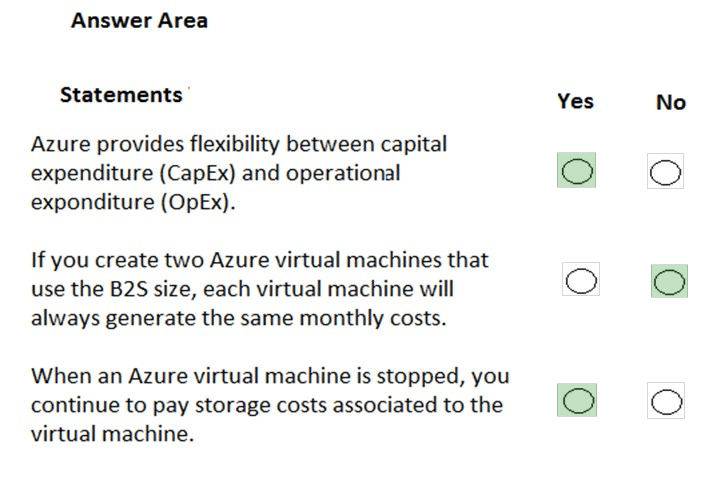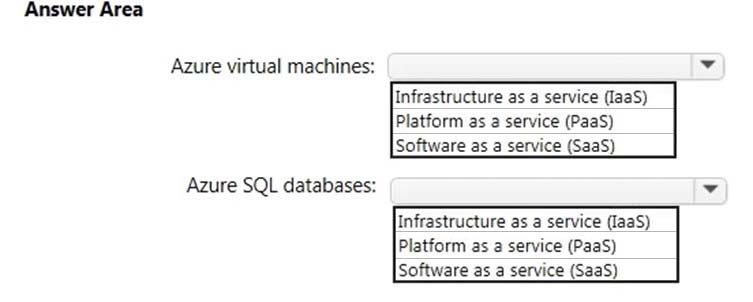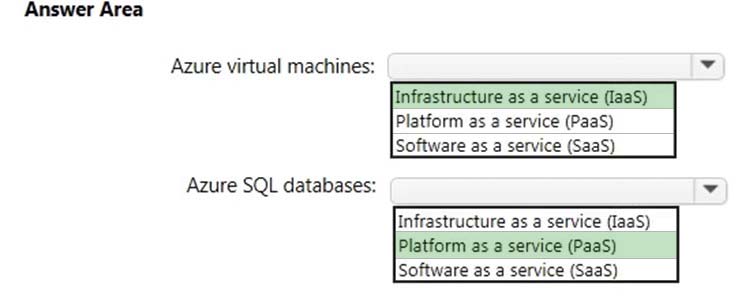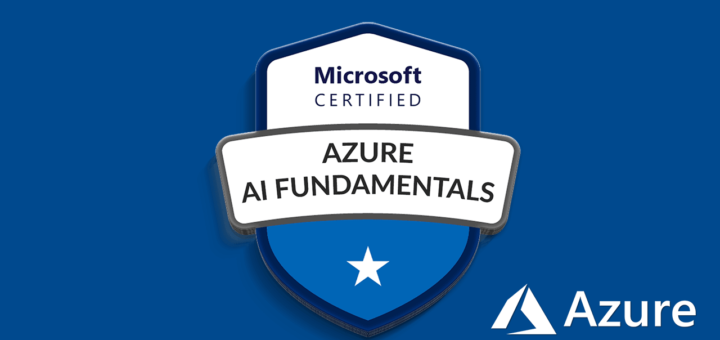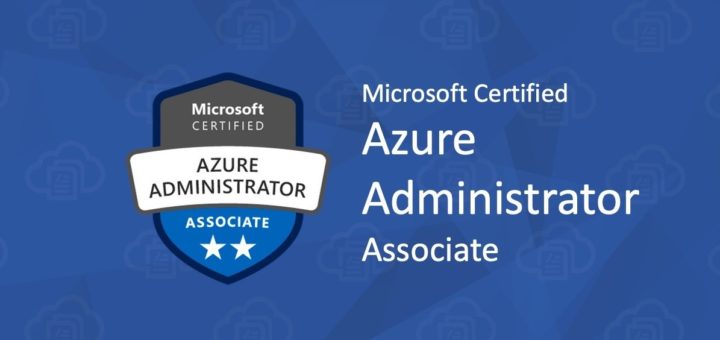HOTSPOT –
For each of the following statements, select Yes if the statement is true. Otherwise, select No.
NOTE: Each correct selection is worth one point.
Hot Area:
Correct Answer:
HOTSPOT –
For each of the following statements, select Yes if the statement is true. Otherwise, select No.
NOTE: Each correct selection is worth one point.
Hot Area:
Correct Answer:
This question requires that you evaluate the underlined text to determine if it is correct.
When you are implementing a software as a service (SaaS) solution, you are responsible for configuring high availability.
Instructions: Review the underlined text. If it makes the statement correct, select “No change is needed”. If the statement is incorrect, select the answer choice that makes the statement correct.
- A. No change is needed.
- B. defining scalability rules
- C. installing the SaaS solution
- D. configuring the SaaS solution
Correct Answer: D
You have an on-premises network that contains several servers.
You plan to migrate all the servers to Azure.
You need to recommend a solution to ensure that some of the servers are available if a single Azure data center goes offline for an extended period.
What should you include in the recommendation?
- A. fault tolerance
- B. elasticity
- C. scalability
- D. low latency
Correct Answer: A
This question requires that you evaluate the underlined text to determine if it is correct.
An organization that hosts its infrastructure in a private cloud can decommission its data center.
Instructions: Review the underlined text. If it makes the statement correct, select “No change is needed”. If the statement is incorrect, select the answer choice that makes the statement correct.
- A. No change is needed.
- B. in a hybrid cloud
- C. in the public cloud
- D. on a Hyper-V host
Correct Answer: C
What are two characteristics of the public cloud? Each correct answer presents a complete solution.
NOTE: Each correct selection is worth one point.
- A. dedicated hardware
- B. unsecured connections
- C. limited storage
- D. metered pricing
- E. self-service management
Correct Answer: DE
This question requires that you evaluate the underlined text to determine if it is correct.
When planning to migrate a public website to Azure, you must plan to pay monthly usage costs.
Instructions: Review the underlined text. If it makes the statement correct, select “No change is needed”. If the statement is incorrect, select the answer choice that makes the statement correct.
- A. No change is needed
- B. Deploy a VPN
- C. pay to transfer all the website data to Azure
- D. reduce the number of connections to the website
Correct Answer: A
Note: This question is part of a series of questions that present the same scenario. Each question in the series contains a unique solution that might meet the stated goals. Some question sets might have more than one correct solution, while others might not have a correct solution.
After you answer a question in this section, you will NOT be able to return to it. As a result, these questions will not appear in the review screen.
Your company plans to migrate all its data and resources to Azure.
The company’s migration plan states that only platform as a service (PaaS) solutions must be used in Azure.
You need to deploy an Azure environment that supports the planned migration.
Solution: You create an Azure App Service and Azure SQL databases.
Does this meet the goal?
- A. Yes
- B. No
Correct Answer: A
Note: This question is part of a series of questions that present the same scenario. Each question in the series contains a unique solution that might meet the stated goals. Some question sets might have more than one correct solution, while others might not have a correct solution.
After you answer a question in this section, you will NOT be able to return to it. As a result, these questions will not appear in the review screen.
Your company plans to migrate all its data and resources to Azure.
The company’s migration plan states that only platform as a service (PaaS) solutions must be used in Azure.
You need to deploy an Azure environment that supports the planned migration.
Solution: You create an Azure App Service and Azure virtual machines that have Microsoft SQL Server installed.
Does this meet the goal?
- A. Yes
- B. No
Correct Answer: B
Note: This question is part of a series of questions that present the same scenario. Each question in the series contains a unique solution that might meet the stated goals. Some question sets might have more than one correct solution, while others might not have a correct solution.
After you answer a question in this section, you will NOT be able to return to it. As a result, these questions will not appear in the review screen.
Your company plans to migrate all its data and resources to Azure.
The company’s migration plan states that only platform as a service (PaaS) solutions must be used in Azure.
You need to deploy an Azure environment that supports the planned migration.
Solution: You create an Azure App Service and Azure Storage accounts.
Does this meet the goal?
Correct Answer: B
Your company hosts an accounting named App1 that is used by all the customers of the company.
App1 has low usage during the first three weeks of each month and very high usage during the last week of each month.
Which benefit of Azure Cloud Services supports cost management for this type of usage pattern?
- A. high availability
- B. high latency
- C. elasticity
- D. load balancing
Correct Answer: C
You plan to migrate a web application to Azure. The web application is accessed by external users.
You need to recommend a cloud deployment solution to minimize the amount of administrative effort used to manage the web application.
What should you include in the recommendation?
- A. software as a service (SaaS)
- B. platform as a service (PaaS)
- C. infrastructure as a service (IaaS)
- D. database as a service (DaaS)
Correct Answer:B
HOTSPOT –
Which cloud deployment solution is used for Azure virtual machines and Azure SQL databases? To answer, select the appropriate options in the answer area.
NOTE: Each correct selection is worth one point.
Hot Area:
Correct Answer:
You have an on-premises network that contains 100 servers.
You need to recommend a solution that provides additional resources to your users. The solution must minimize capital and operational expenditure costs.
What should you include in the recommendation?
- A. a complete migration to the public cloud
- B. an additional data center
- C. a private cloud
- D. a hybrid cloud
Correct Answer:C
HOTSPOT –
For each of the following statements, select Yes if the statement is true. Otherwise, select No.
NOTE: Each correct selection is worth one point.
Hot Area:
Correct Answer:
You plan to migrate several servers from an on-premises network to Azure.
You need to identify the primary benefit of using a public cloud service for the servers.
What should you identify?
- A. The public cloud is owned by the public, NOT a private corporation
- B. The public cloud is a crowd-sourcing solution that provides corporations with the ability to enhance the cloud
- C. All public cloud resources can be freely accessed by every member of the public
- D. The public cloud is a shared entity whereby multiple corporations each use a portion of the resources in the cloud
Correct Answer:D
Note: This question is part of a series of questions that present the same scenario. Each question in the series contains a unique solution that might meet the stated goals. Some question sets might have more than one correct solution, while others might not have a correct solution.
After you answer a question in this section, you will NOT be able to return to it. As a result, these questions will not appear in the review screen.
You plan to deploy several Azure virtual machines.
You need to ensure that the services running on the virtual machines are available if a single data center fails.
Solution: You deploy the virtual machines to two or more scale sets.
Does this meet the goal?
Correct Answer:B
References:
https://docs.microsoft.com/en-us/azure/virtual-machines/windows/regions-and-availability
Note: This question is part of a series of questions that present the same scenario. Each question in the series contains a unique solution that might meet the stated goals. Some question sets might have more than one correct solution, while others might not have a correct solution.
After you answer a question in this section, you will NOT be able to return to it. As a result, these questions will not appear in the review screen.
You plan to deploy several Azure virtual machines.
You need to ensure that the services running on the virtual machines are available if a single data center fails.
Solution: You deploy the virtual machines to two or more availability zones.
Does this meet the goal?
- A. Yes
- B. No
Correct Answer:A
References:
https://docs.microsoft.com/en-us/azure/virtual-machines/windows/regions-and-availability
Note: This question is part of a series of questions that present the same scenario. Each question in the series contains a unique solution that might meet the stated goals. Some question sets might have more than one correct solution, while others might not have a correct solution.
After you answer a question in this section, you will NOT be able to return to it. As a result, these questions will not appear in the review screen.
You plan to deploy several Azure virtual machines.
You need to ensure that the services running on the virtual machines are available if a single data center fails.
Solution: You deploy the virtual machines to two or more regions.
Does this meet the goal?
- A. Yes
- B. No
Correct Answer:B
References:
https://docs.microsoft.com/en-us/azure/virtual-machines/windows/regions-and-availability
You have 1,000 virtual machines hosted on the Hyper-V hosts in a data center.
You plan to migrate all the virtual machines to an Azure pay-as-you-go subscription.
You need to identify which expenditure model to use for the planned Azure solution.
Which expenditure model should you identify?
- A. operational
- B. elastic
- C. capital
- D. scalable
Correct Answer:A
References:
https://docs.microsoft.com/en-us/azure/architecture/cloud-adoption/appendix/azure-scaffold

